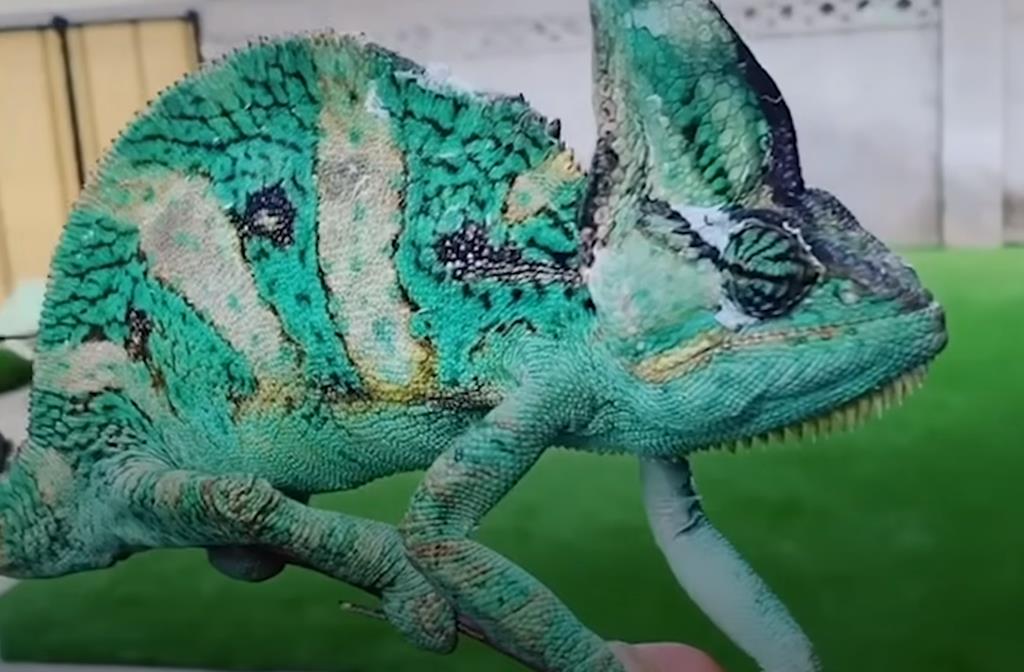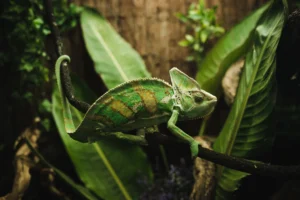Veiled chameleons can be fascinating pets for experienced reptile keepers who are willing to invest time, effort, and resources into meeting their specific care needs. However, they may not be suitable for beginners due to their complex requirements and sensitivity.
Veiled chameleons, iconic for their impressive eye turrets and vivid color-changing abilities, present a unique challenge to pet owners. Due to their specific humidity and temperature needs, as well as a diet consisting of live insects, they require dedicated attention and a commitment to creating a suitable habitat.
These solitary and often territorial reptiles are best suited for those with experience in reptile care, as they are not typically affectionate and do not enjoy being handled frequently. Observing a veiled chameleon in a well-maintained vivarium can be rewarding, yet potential owners must research and prepare for the responsibility that comes with such an exotic pet. Their distinct personalities and striking appearance make them fascinating, if demanding, companions for the right person.
The Allure Of The Veiled Chameleon
Veiled chameleons capture the hearts of pet lovers around the world. Their vibrant colors and graceful movements make them standout pets. Understanding their origins and behaviors enriches the experience of keeping these reptiles. Let’s explore why veiled chameleons might just be the perfect showpiece in your home!
Vibrant Colors And Expressive Behavior
Veiled chameleons are living art pieces. With a spectrum of colors, they communicate feelings and health. Colors change with mood, temperature, and health. This unique trait fascinates owners and guests alike.
- Bright green indicates relaxation
- Dark patches may signal stress or aggression
- Color transformations aid in camouflage
These creatures also possess expressive body language. They sway to mimic leaves in the wind, adding a captivating dynamic to their presence. They extend their limbs and rotate their turret-like eyes independently, constantly surveying surroundings. This behavior is not just intriguing but also a window into their wellbeing.
Ecological Origin And Natural Habitat
Understanding a veiled chameleon’s natural setting is key for optimal care. They hail from the Arabian Peninsula, adapted to arid mountainous regions. Their comfort at home reflects their wild habitat requirements.
- Warm temperatures are a must
- Low humidity levels replicate their natural environment
- They favor vertical space to climb and perch
Creating a mini habitat that mimics their natural home ensures happy and healthy chameleons. This involves setups with ample foliage and branches for climbing. It also requires carefully regulated lighting and temperature to keep their delicate bodies thriving.
Physical Traits And Behavior
Veiled chameleons fascinate with their unique looks and actions. They make intriguing pets for reptile enthusiasts. Their care requires dedication and understanding for a happy life.
Unique Physiological Features
Veiled chameleons display remarkable physical traits that make them stand out in the reptile world. These include:
- Large casques on their heads that help with hydration.
- Zygodactyl feet for a tight grip on branches.
- Independently mobile eyes to look in two directions at once.
- Prehensile tails for balance and support in trees.
Communication Through Color Change
Veiled chameleons are like living mood rings. They change colors to talk to other chameleons and show their feelings. Here are the reasons behind their color shifts:
| Color Change | Meaning |
|---|---|
| Brighter colors | Showing off to attract mates or when basking. |
| Darker shades | Feeling cold or trying to warm up. |
| Bold patterns | Defending territory or signaling distress. |
Caring For A Veiled Chameleon
Think chameleons make awesome pets? You are right! They do. Especially veiled chameleons. These colorful creatures need proper care to stay happy and healthy. Keep reading to learn all about how to care for your new friend!
Habitat Setup: Terrarium Requirements
A veiled chameleon’s home is super important. They need the right space to climb and hide. Here’s what to put in their terrarium:
- Size matters! A tall enclosure, at least 24 inches by 24 inches by 36 inches, is ideal.
- Real plants provide excellent hiding spots. Plus, they help keep the air moist.
- Branches for climbing are a must. They love to move up and down a lot.
- Don’t forget the UVB light. It helps them make vitamin D and keep their bones strong.
- Keep the temperature perfect, between 72°F to 80°F during the day.
Dietary Needs: What To Feed Your Chameleon
A happy chameleon eats well. They like munching on a variety of insects. Check out their menu:
- Crickets and mealworms are great. They’re like chameleon fast food!
- Greens and veggies can be offered sometimes. They’re like salads for them.
- Calcium dust on their food? Yes, please! It keeps them strong.
- Water should be misted. They drink the droplets off leaves.
Regular Maintenance: Cleaning And Health Monitoring
Maintaining a chameleon’s home is part of the fun. Follow these tips:
| Task | Frequency |
|---|---|
| Spot cleaning | Every day |
| Full cleaning | Every month |
| Health check | Weekly |
- Check for poops daily and remove them.
- Replace water for misting often to keep it fresh.
- Watch your buddy’s color and activity. Changes can mean they need a vet.
Potential Challenges
Embracing a veiled chameleon as a pet involves challenges unique to their species. These exotic reptiles come with a set of needs that require a well-informed owner to adequately address. Understanding the complexities can ensure a healthy and enjoyable life for your feisty friend, and prepare you as a pet parent for the responsibilities that lie ahead.
Handling Sensitivity: Stress And Aggression
Veiled chameleons prefer minimal handling. Their solitary nature means stress levels can soar with too much interaction, often resulting in aggression. To maintain a peaceful environment, learn to interpret their colors and body language as indicators of mood and stress. Keep handling sessions brief and infrequent to avoid unnecessary anxiety for your pet.
Medical Concerns: Common Health Issues
Being proactive with health is critical. Common ailments include metabolic bone disease due to inadequate UVB exposure and improper nutrition, respiratory infections from incorrect humidity levels, and kidney failure related to dehydration. Establish a vet relationship early for regular check-ups.
- Metabolic Bone Disease: Requires UV light and proper diet.
- Respiratory Infections: Keep humidity in check.
- Kidney Failure: Ensure hydration with dripping water.
Life Expectancy And Breeding Considerations
A veiled chameleon’s life span can span up to 8 years with optimal care. Females often have shorter life spans due to the stress of laying eggs, even without a male present. Breeding chameleons can be intense—it requires a deep understanding of their needs to avoid complications for both mother and offspring.
| Aspect | Detail |
|---|---|
| Life Span | 5-8 years |
| Female Health | Shorter due to egg-laying |
Legal And Ethical Considerations
Veiled chameleons can be fascinating pets, but it’s important to understand the rules and ethical implications. Before deciding to bring a veiled chameleon into your home, consider the impact on both the environment and the species itself. Let’s explore what you need to know.
Regulations On Chameleon Ownership
Owning a chameleon comes with regulations. Different areas have different rules. You should check your local laws before getting a chameleon. Some places require permits. Others may prohibit chameleon ownership entirely. This helps protect local ecosystems from unintended impacts.
- Always verify with wildlife agencies about permits and restrictions.
- Understand that owning a chameleon may be subject to change as laws evolve.
- Ensure to acquire your pet from licensed dealers to adhere to legal standards.
Impact Of Pet Trade On Wild Populations
The pet trade can hurt wild chameleon populations. Overcollecting for pet sales affects their numbers. It disrupts their natural habitats. Sustainable practices are crucial to protect these creatures for the future.
| Aspect | Impact |
|---|---|
| Overcollection | Reduces wild populations, risking endangerment. |
| Habitat Disruption | Harms ecosystem balance, affecting other species. |
| Sustainable Practices | Supports long-term survival of chameleons. |
Consider adopting a chameleon instead of buying. This helps reduce demand on wild populations. Support organizations working to safeguard wildlife and promote ethical pet ownership.
Making The Decision
Deciding to bring a veiled chameleon into your home is no small task. These colorful creatures are captivating to watch, with their vivid colors and unique ability to change shades. Yet, caring for a veiled chameleon is a serious commitment. Before making your decision, consider the pros and cons, and understand the responsibilities of a veiled chameleon caretaker.
Weighing Pros And Cons
Think about the following advantages and disadvantages:
| Pros of Veiled Chameleons | Cons of Veiled Chameleons |
|---|---|
| Stunning, ever-changing colors | Need for a carefully controlled environment |
| Unique, interactive behavior | More sensitive to stress than other pets |
| Potential longevity with proper care | Can be expensive to maintain |
Responsibilities Of Veiled Chameleon Caretakers
Caring for a veiled chameleon goes beyond basic feeding and cleaning. Be ready to tackle these tasks:
- Creating a suitable habitat: This includes maintaining temperature and humidity.
- Regular health check-ups: Monitoring signs of stress or illness is key.
- Diet management: Veiled chameleons need a varied diet with supplements.
- Handling with care: They are delicate and require gentle interaction.
Frequently Asked Questions For Are Veiled Chameleons Good Pets?
Are Veiled Chameleons Friendly Pets?
Veiled chameleons are generally not very friendly. They prefer solitude and can get stressed with frequent handling. Their tolerance for interaction varies individually but they’re better observed than cuddled.
Do Veiled Chameleons Require Special Care?
Yes, veiled chameleons require specific care. They need a well-maintained habitat with proper temperature, humidity, and lighting. A balanced diet and regular veterinary check-ups are also essential for their well-being.
How Long Do Veiled Chameleons Live?
With proper care, veiled chameleons can live between 5 to 8 years. Lifespan can vary based on factors such as environment, diet, and overall quality of care.
Can Veiled Chameleons Be Handled?
Veiled chameleons can be handled, but sparingly. Over-handling can cause stress and potential health issues. It’s important to be gentle and patient when handling them to build trust.
Conclusion
Veiled chameleons can make fascinating pets for the right owner. Their vivid colors and unique behaviors offer a captivating experience. Still, they require dedicated care and attention to thrive. Before taking the leap, ensure you’re ready for the commitment they demand.
With proper preparation, a veiled chameleon could be a rewarding companion.

